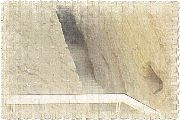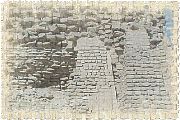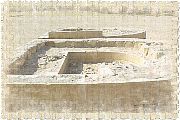 |
Immediately
to the south of this chapel the so-called "South Tomb" can be
found. It is one of the most enigmatic parts of the entire complex.
A wide and deep shaft leads to a maze of rooms and corridors.
The burial chamber is too small to actually have contained any
human remains. An acceptable hypothesis explains the "South
Tomb" as a tomb for a statue of the king, or of his Ka.
 |

View of the South Tomb Entrance |
 |
The
western perimeter of the "South Court" was formed by a long,
narrow building erected above a maze of subterranean rooms and
corridors, which may perhaps have been a royal tomb of the 2nd
Dynasty. To the north of the "South Court" stands the Step Pyramid,
king Djoser’s funerary monument. The restoration of this monument
in the early 20th century has revealed that it was built in
different stages.
 |

Close-up on the Step Pyramid |
 |
|
 |
During
the first stage, the monument was nothing more then a low,
rectangular building. This building is usually interpreted
as a "mastaba", the typical structure built above an Early
Dynastic or Old Kingdom private tomb. Comparison with older
royal tombs, however, makes it likely that the original structure
that stood slightly off-centre in the Djoser complex may have
represented the primeval mound from which the Ancient Egyptians
believed all life sprang.
This
original structure was then extended. Three new rectangular
structures, each smaller than the previous one, were then
built on top of it, resulting in a pyramid-like building with
four steps. During the last stage, the four steps were extended
towards the north and east and two new steps were added on
top of the existing ones. The final result was a step pyramid
with six steps towering to a height of about 60m.
This
step pyramid was built on top of the subterranean tomb of
the king. The extension of the original step pyramid toward
the east also covered some shafts leading down to other subterranean
tombs. It has been assumed that these tombs belonged to members
of Djoser’s immediate family, but recent research appears
to indicate that the remains that were deposited in the tombs
would date from before Djoser’s time.
Immediately
in front of the step pyramid facing south, a raised podium
can be found. It may have been intended for the king or for
a statue representing him during some ritual. Two stone structures,
each representing the letter B from our alphabet, were constructed
in the open area between this podium and the "South Tomb".
|
 |
 |

The 'B' shaped structures |
 |
These
structures were intended as a symbolic representation of the
borders of Egypt. On specific occasions, the king would perform
a ritual run between the two structures, thus symbolically encompassing
the entire country.
In
the east wall of the "South Court", a narrow passage leads
to a smaller court on the east side of the complex. A small
building just before the passage is now called "Temple T".
Unlike most other buildings in the complex it has a small
but usable inner chamber. It is believed that "Temple T" may
have been intended as a resting-place for the king during
the ritual activities.
The
smaller court on the east side of the complex is now called
the "Heb Sed" court. A podium with the two sets of steps is
interpreted as the podium that can often be seen in representations
of the "Heb Sed" ritual.This ritual was enacted at particular
stages in a king’s reign. Although we do not grasp the entire
meaning of the ritual, it is clear that it was intended to
magically rejuvenate the king. The presence of a structure
related to this ritual in a mortuary complex is not surprising:
it would allow the deceased king to rejuvenate himself eternally.
(Jacques
Kinnaer)
|